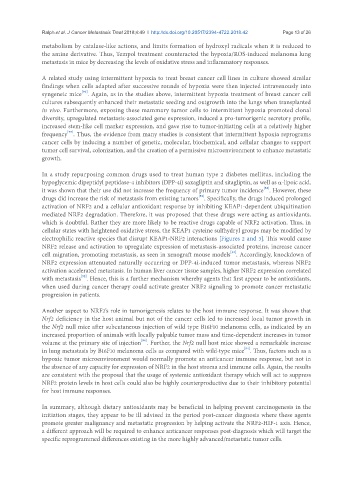Page 593 - Read Online
P. 593
Ralph et al. J Cancer Metastasis Treat 2018;4:49 I http://dx.doi.org/10.20517/2394-4722.2018.42 Page 13 of 26
metabolism by catalase-like actions, and limits formation of hydroxyl radicals when it is reduced to
the amine derivative. Thus, Tempol treatment counteracted the hypoxia/ROS-induced melanoma lung
metastasis in mice by decreasing the levels of oxidative stress and inflammatory responses.
A related study using intermittent hypoxia to treat breast cancer cell lines in culture showed similar
findings when cells adapted after successive rounds of hypoxia were then injected intravenously into
[93]
syngeneic mice . Again, as in the studies above, intermittent hypoxia treatment of breast cancer cell
cultures subsequently enhanced their metastatic seeding and outgrowth into the lungs when transplanted
in vivo. Furthermore, exposing these mammary tumor cells to intermittent hypoxia promoted clonal
diversity, upregulated metastasis-associated gene expression, induced a pro-tumorigenic secretory profile,
increased stem-like cell marker expression, and gave rise to tumor-initiating cells at a relatively higher
[93]
frequency . Thus, the evidence from many studies is consistent that intermittent hypoxia reprograms
cancer cells by inducing a number of genetic, molecular, biochemical, and cellular changes to support
tumor cell survival, colonization, and the creation of a permissive microenvironment to enhance metastatic
growth.
In a study repurposing common drugs used to treat human type 2 diabetes mellitus, including the
hypoglycemic dipeptidyl peptidase-4 inhibitors (DPP-4i) saxagliptin and sitagliptin, as well as α-lipoic acid,
[52]
it was shown that their use did not increase the frequency of primary tumor incidence . However, these
[52]
drugs did increase the risk of metastasis from existing tumors . Specifically, the drugs induced prolonged
activation of NRF2 and a cellular antioxidant response by inhibiting KEAP1-dependent ubiquitination
mediated NRF2 degradation. Therefore, it was proposed that these drugs were acting as antioxidants,
which is doubtful. Rather they are more likely to be reactive drugs capable of NRF2 activation. Thus, in
cellular states with heightened oxidative stress, the KEAP1 cysteine sulfhydryl groups may be modified by
electrophilic reactive species that disrupt KEAP1-NRF2 interactions [Figures 2 and 3]. This would cause
NRF2 release and activation to upregulate expression of metastasis-associated proteins, increase cancer
[52]
cell migration, promoting metastasis, as seen in xenograft mouse models . Accordingly, knockdown of
NRF2 expression attenuated naturally occurring or DPP-4i-induced tumor metastasis, whereas NRF2
activation accelerated metastasis. In human liver cancer tissue samples, higher NRF2 expression correlated
[52]
with metastasis . Hence, this is a further mechanism whereby agents that first appear to be antioxidants,
when used during cancer therapy could activate greater NRF2 signaling to promote cancer metastatic
progression in patients.
Another aspect to NRF2’s role in tumorigenesis relates to the host immune response. It was shown that
Nrf2 deficiency in the host animal but not of the cancer cells led to increased local tumor growth in
the Nrf2 null mice after subcutaneous injection of wild type B16F10 melanoma cells, as indicated by an
increased proportion of animals with locally palpable tumor mass and time-dependent increases in tumor
[94]
volume at the primary site of injection . Further, the Nrf2 null host mice showed a remarkable increase
[94]
in lung metastasis by B16F10 melanoma cells as compared with wild-type mice . Thus, factors such as a
hypoxic tumor microenvironment would normally promote an anticancer immune response, but not in
the absence of any capacity for expression of NRF2 in the host stroma and immune cells. Again, the results
are consistent with the proposal that the usage of systemic antioxidant therapy which will act to suppress
NRF2 protein levels in host cells could also be highly counterproductive due to their inhibitory potential
for host immune responses.
In summary, although dietary antioxidants may be beneficial in helping prevent carcinogenesis in the
initiation stages, they appear to be ill advised in the period post-cancer diagnosis where these agents
promote greater malignancy and metastatic progression by helping activate the NRF2-HIF-1 axis. Hence,
a different approach will be required to enhance anticancer responses post-diagnosis which will target the
specific reprogrammed differences existing in the more highly advanced/metastatic tumor cells.

